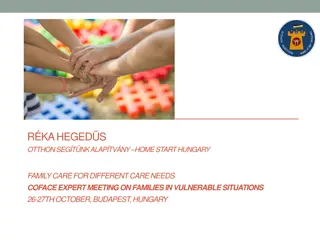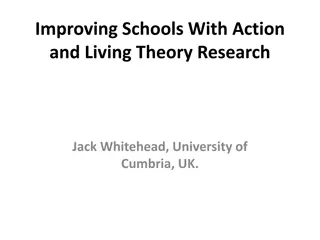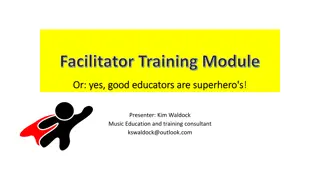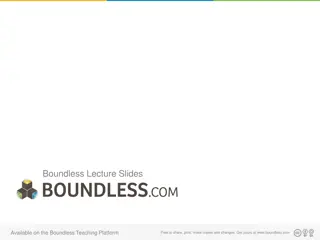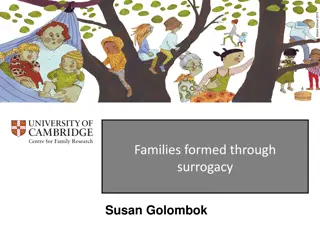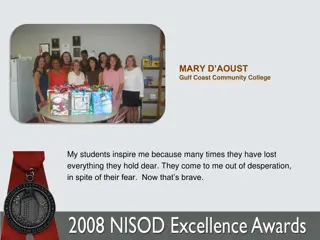Empowering Educators: Teaching About Families and Relationships Training Module
Equip subject leads with adaptable resources for teaching about families and caregivers in primary and secondary education. Enhance confidence in delivering statutory guidance, covering key knowledge, facts, and strategies for classroom discussions.
Download Presentation

Please find below an Image/Link to download the presentation.
The content on the website is provided AS IS for your information and personal use only. It may not be sold, licensed, or shared on other websites without obtaining consent from the author.If you encounter any issues during the download, it is possible that the publisher has removed the file from their server.
You are allowed to download the files provided on this website for personal or commercial use, subject to the condition that they are used lawfully. All files are the property of their respective owners.
The content on the website is provided AS IS for your information and personal use only. It may not be sold, licensed, or shared on other websites without obtaining consent from the author.
E N D
Presentation Transcript
ADAPT THIS FOR YOUR OWN PRESENTATION Training module Teaching about families and people who care for me (primary), families (secondary) Part of: Relationships education (primary) Relationships and sex education (secondary) [YOUR NAME, YOUR SCHOOL] Primary Secondary May 2023
Contents 3 About this training module 5 Teaching the new curriculum 16 Safeguarding 19 Ground rules 22 Primary curriculum 38 Secondary curriculum 61 Examples of good practice 66 Activities and templates for trainers 2
About this training module Subject leads can use the adaptable slides and activities and templates for trainers section at the end of this module to help shape training sessions for teachers. This non-statutory training module supplements the statutory guidance on teaching about families and people who care for me (primary) and families (secondary), which schools should read in full. Schools can choose whether and how to follow or adapt this training module and should refer to the Early Career Framework for pedagogical guidance. 3
What you get out of today By the end of this training you should: know what is included in the statutory guidance know some key knowledge and facts to cover as part of this topic have strategies to deal with questions that come up in class feel more confident teaching about families 4
Related topics This module on families is closely related to the following topics: being safe respectful relationships caring friendships online relationships Therefore, you should: consider thematic links across key topics and the whole school when planning and delivering lessons find ways to link knowledge and vocabulary across topics 6
Related guidance Schools may also want to refer to the following related guidance when planning to teach this subject: guidance for schools on preventing and responding to bullying (including cyberbullying) keeping children safe in education 7
Support at [school name] Our leads [Names, contact details - e.g. safeguarding lead] Our policies [Add details - e.g. school policy on PSHE, training opportunities] Specialist support [Add details - e.g. providers school already works with] Other information [Add resources - e.g. support from designated teachers for looked- after children at the school] 8
Teaching about families at [school name] Ways in which we already teach about families at our school: [add details] [add details] [add details] 9
Primary and secondary teaching Some slides in this training have a Primary or Secondary label to indicate that the material is usually first introduced in that phase. STATUTORY GUIDANCE Schools have flexibility to design and plan age-appropriate subject content. (p31) Using your knowledge of your pupils and school community you can: introduce secondary content in primary with pupils who need it and are ready (with parental engagement where required) teach the primary content in early secondary lessons to pupils who need to build knowledge before secondary content is taught 10
LGBT needs and inclusion Primary schools are enabled and encouraged to cover LGBT (lesbian, gay, bisexual and transgender) content if they consider it age appropriate to do so. Secondary schools should include LGBT content. When doing so, schools should ensure: LGBT-relevant knowledge and examples are included throughout programmes of study (not one-off teaching) inclusive language is used, considering how individual pupils may relate to particular topics 11
Faith backgrounds All schools must ensure the faith/religious background of pupils are taken into account when planning teaching, so that topics are appropriately handled. STATUTORY GUIDANCE In all schools, when teaching these subjects, the religious background of all pupils must be taken into account when planning teaching, so that the topics that are included in the core content in this guidance [the statutory guidance] are appropriately handled. (p12) 12
Pupils with SEND You will need to plan lessons to allow all pupils to access and practise the core knowledge, using your expertise as you normally would. You might want to link lesson outcomes with statutory preparing for adulthood outcomes for those with an education, health and care (EHC) plan. (See SEND code of practice, section 8.) STATUTORY GUIDANCE In special schools and for some SEND pupils in mainstream schools there may be a need to tailor content and teaching to meet the specific needs of pupils at different developmental stages. As with all teaching for these subjects, schools should ensure that their teaching is sensitive, age-appropriate, developmentally appropriate and delivered with reference to the law. (p15) 13
Teacher wellbeing The new curriculum covers a wide range of topics, some of which individual teachers might find personally challenging in different ways. It is important to feel you can ask for support or raise questions if: you have personal experience of a topic which makes teaching that content particularly challenging for you you have personal views on a topic that mean you need to discuss how you can ensure the teaching is delivered objectively Talk to your line manager, in the first instance, if you do need support. 14
References to the law The references to the law in this module are given as a teacher resource if needed. They are not exhaustive. Teachers are not expected to be able to teach the details of the law or to be able to answer complex questions that may come up about the law. 15
Safeguarding 16
Safeguarding (1) Pupils may be affected by issues discussed in lessons. Let your designated safeguarding lead or deputy and any other relevant staff, such as pastoral leads, know what you are teaching. This will enable them to identify and speak to relevant pupils, especially those who they know may have been directly impacted by issues covered in the lessons and those with adverse childhood experiences. Teachers may need to deal with disclosures or concerns (e.g. of abuse or offending behaviour) in a way that safeguards pupils in line with school policies, especially the child protection policy. 17
Trusted adults Within this module we have used the term trusted adult. A trusted adult will generally be someone who children feel comfortable to turn to for help. Obvious examples include family members, teachers and doctors. It will be important when teaching this topic, and any other relevant topics, that teachers explore this concept. Pupils should be comfortable and capable of identifying who their trusted adults could be both within their families and wider circles. 18
Ground rules 19
Create class ground rules Clear class ground rules can help when teaching about sensitive topics. They also support confidentiality and safeguarding of pupils. Good practice is for ground rules to be: discussed and understood by all clear and practical modelled by the teacher followed consistently and enforced updated when needed visible in lessons (for example, posters) 20
Example ground rules Respect privacy. We can discuss examples but do not use names or descriptions that identify anyone, including ourselves. Listen to others. It is okay to disagree with each other, but we should listen properly before making assumptions or deciding how to respond. When disagreeing, challenge the statement not the person. No judgement. We can explore beliefs and misunderstandings about a topic without fear of being judged. Choose level of participation. Everyone has the right to choose not to answer a question or join discussion. We never put anyone on the spot (no personal questions or pressure to answer). 21
Introducing the family STATUTORY GUIDANCE Know that families are important for children growing up because they can give love, security and stability. Schools will need to be sensitive to pupils individual circumstances when planning lessons and teaching about the different ways in which families are important to children as they grow up. Teachers should ensure: descriptions of families are inclusive of pupils own experiences where needed, individual pupils are supported to identify their significant family members and wider support network (this may happen outside the classroom) Primary 24
Security, love and guidance STATUTORY GUIDANCE Know that families are important for children growing up because they can give love, security and stability. Explain that human beings have a family to: meet our basic needs (e.g. food, clothing, shelter) keep us safe (e.g. healthcare, teaching road safety) provide security and stability, including during times of change (e.g. starting a new school) Families also provide love and guidance. They: give us a sense of belonging and self-esteem (e.g. spending time together, celebrating achievements) give us love and emotional support (e.g. when we are unhappy or worried about things) help us learn new things (e.g. discover our talents or show us how to behave in different situations) Primary 25
Support when we need it most STATUTORY GUIDANCE Know that families are important for children growing up because they can give love, security and stability. Teach that the love and security families provide can be particularly important when: things change in our lives (e.g. new siblings, loss of a family member, moving home) we have problems or worries (e.g. we are in trouble for something or someone has upset us) Explain that children can themselves provide important love and support for other family members too, e.g. being patient and caring towards their parents or siblings. Primary 26
Different types of family STATUTORY GUIDANCE Know that others families sometimes look different from their family, but that they should respect those differences and know that other children s families are also characterised by love and care. Teach pupils that there are many types and sizes of families. For example: some children live with a parent or parents some children live with other family members such as grandparents or older siblings some children live with a foster family or in another type of home Some people are the only child in their family while others have siblings. Explain that all types of families can provide the love and care that children need. Primary 27
Respecting difference STATUTORY GUIDANCE Know that others families sometimes look different from their family, but that they should respect those differences and know that other children s families are also characterised by love and care. Teach that every family is different. It is important to respect different kinds of families and not expect other people's families to be the same as our own. For example, someone s family member might look, sound or behave differently from ours, or do a different job. Explain that pupils have a right to expect people to treat their family with respect. If someone says something about our family that is hurtful or confusing we can speak to a teacher or parent/carer. Related module: respectful relationships Primary 28
Appreciating diversity STATUTORY GUIDANCE Know that others families sometimes look different from their family, but that they should respect those differences and know that other children s families are also characterised by love and care. Teaching about families can provide an opportunity for pupils to appreciate diversity within their school and wider community. For example, schools may want to build pupils awareness and understanding of disability by selecting resources that feature children and other family members with a range of visible and invisible disabilities. Primary 29
Healthy family life STATUTORY GUIDANCE Know the characteristics of healthy family life. Know that stable, caring relationships, which may be of different types, are at the heart of happy families, and are important for children s security as they grow up. Explain that healthy and caring family life includes: a safe and encouraging environment for children time spent together respect and support for each other, including in difficult times dealing with problems in a caring and supportive way Explain that these things make a family feel safe and can help to shape how we relate to other people. Primary 31
Difficult times in families STATUTORY GUIDANCE Know the characteristics of healthy family life. Know that stable, caring relationships, which may be of different types, are at the heart of happy families, and are important for children s security as they grow up. Teach that many healthy families experience problems and disagreements. Explain that it is normal to be upset with family members occasionally. Sometimes problems make people feel emotions such as unhappiness or anger, and it can help to: communicate how we feel listen to each other Explain that if a child is worried about their emotions or mental wellbeing they can ask for help from a family member or another trusted adult. Primary 32
Unhappy or unsafe relationships STATUTORY GUIDANCE Know how to recognise if family relationships are making them feel unhappy or unsafe, and how to seek help or advice from others if needed. While most children will experience a happy and safe family life, schools should teach pupils to recognise feelings of being unsafe with or bad about another person, including a family member. Explore with sensitivity, experiences that can make us feel unsafe, such as being: bullied or shouted at a lot with hurtful words physically attacked touched in a way that makes them uncomfortable asked to keep secrets that make them feel bad witness to harmful behaviour (e.g. alcoholism) Primary 34
How to ask for help or advice STATUTORY GUIDANCE Know how to recognise if family relationships are making them feel unhappy or unsafe, and how to seek help or advice from others if needed. Teach that pupils can ask a trusted adult (e.g. a teacher or family member) if anyone, including someone in their family, makes them feel unsafe. Teach that adults should listen to and take children s feelings and experiences seriously. If a pupil feels they are not being heard, or they want to Childline speak anonymously about anything they can call Childline on 0800 1111. Remind pupils of the people within the school that they can speak to if they need support. Related module: being safe Primary 35
Marriage 36
Marriage STATUTORY GUIDANCE Know that marriage represents a formal and legally recognised commitment of 2 people to each other which is intended to be lifelong. Teach that in England marriage is when 2 people make a legal commitment to be partners for life. People choose to make this commitment for different reasons: for a sense of security, or wish to permanently join their life and build a family with a particular person to make a religious commitment as well as a legal one With sensitivity to pupils own experiences, explain that while marriage is intended to be lifelong, sometimes marriages end. Primary 37
Secondary curriculum STATUTORY GUIDANCE Schools should continue to develop knowledge on topics specified for primary as required and in addition cover the following content by the end of secondary. (p36) 38
Types of committed relationship STATUTORY GUIDANCE Know that there are different types of committed, stable relationships. Explain that a committed relationship is when 2 people agree to be in a long-term relationship. Examples can include: being committed partners but living apart cohabiting in a committed relationship marriage or civil partnership Give examples of a range of stable, committed relationships. Explain that people are free to make relationship choices that are right for them. Secondary 40
Diverse relationships and families STATUTORY GUIDANCE Know that there are different types of committed, stable relationships. Teachers can expand on primary teaching by giving further examples of diversity in relationships and families. Examples may include: LGBT partners/parents single parents/carers step-families foster and adoptive families intergenerational families (e.g. families that include grandparents) Resources used to depict family groups should also be inclusive of wider diversity (e.g. disability, race, religion). Secondary 41
Happiness and bringing up children STATUTORY GUIDANCE Know how [committed] relationships might contribute to human happiness and their importance for bringing up children. Explain that healthy, committed relationships can contribute to people s happiness by providing: love and intimacy enjoyment of time spent together an opportunity to share everyday experiences and significant moments in life a sense of support in facing life s challenges Explain that a family where people love and are committed to each other provides a good environment for bringing up children. Secondary 42
A nurturing environment STATUTORY GUIDANCE Know how [committed] relationships might contribute to human happiness and their importance for bringing up children. Teach that there are many things that affect how a child will grow up, but the environment provided by parents and carers plays a crucial role. Explain that a commitment to providing a loving and safe environment for a child is important. For example, through positive interactions with parents and carers, a child will learn they are valued, and they will value themselves. This will help to shape how they interact with others, inside and outside of the family. Remind pupils that all kinds of families can provide this nurturing environment, including care settings. Secondary 43
Responsibilities of parents/carers STATUTORY GUIDANCE Know the roles and responsibilities of parents with respect to raising of children, including the characteristics of successful parenting. Explain that parents and carers have responsibility for a child s needs, safety and development, e.g.: supporting physical, social and emotional development and wellbeing supporting education creating security and a sense of home meeting basic needs (e.g. food, drink and clothing) providing a loving environment supporting them to understand right and wrong seeking to provide guidance as they progress through life Secondary 44
Marriage, civil partnerships and cohabitation 45
Introducing marriage STATUTORY GUIDANCE Know what marriage is, including its legal status e.g. that marriage carries legal rights and protections not available to couples who are cohabiting or who have married, for example, in an unregistered religious ceremony. Know why marriage is an important relationship choice for many couples... Teach that marriage in England is a formal and legally binding long-term union of 2 people as partners. Couples marry for many reasons, including because: they have chosen to remain committed they believe marriage provides stability for a family they want additional legal rights and protections marriage is important in their religion, culture or tradition Teachers may explain the process of marriage (e.g. witnesses, giving notice) and explore some of the ways in which marriage is celebrated in different cultures. Secondary 46
Who can marry STATUTORY GUIDANCE Know what marriage is, including its legal status e.g. that marriage carries legal rights and protections not available to couples who are cohabiting or who have married, for example, in an unregistered religious ceremony. Explain that in England people can get married at age 18. Teach that in England, 2 people of either sex can legally marry (e.g. same-sex couples). Teachers may also want to give examples of people who cannot marry, such as: people who are already currently married people who are related in certain ways, e.g. siblings Teachers should note the Marriage and Civil Partnership (Minimum Age) Act 2022. Secondary 47
Marriage rights and protections (1) STATUTORY GUIDANCE Know what marriage is, including its legal status e.g. that marriage carries legal rights and protections not available to couples who are cohabiting or who have married, for example, in an unregistered religious ceremony. Teach that married couples have certain legal rights and protections. For example, married couples: have automatic parental rights over their child have a legal duty to financially support each other and their children both have a right to live in the matrimonial home can claim tax allowances aimed at married couples Secondary 48
Marriage rights and protections (2) STATUTORY GUIDANCE Know what marriage is, including its legal status e.g. that marriage carries legal rights and protections not available to couples who are cohabiting or who have married, for example, in an unregistered religious ceremony. Married couples and civil partners usually: have a right to their own assets (e.g. property), but these may be taken into consideration if you choose to divorce have the right to a partner s assets when they die, without paying inheritance tax, provided anything over the inheritance tax threshold has been left to the partner in a will inherit at least part of their partner s estate if the person who died doesn t leave a will, under the rules of intestacy Secondary 49
Freedom to consent to marriage STATUTORY GUIDANCE Know why marriage must be freely entered into. Teach that marriage must always be freely entered into with the consent of both people. This means each person has the right to: choose if, when and who they marry withdraw their consent if they change their mind about getting married Forced marriage, where people do not freely consent, is against the law. The being safe module provides more information on both consent and forced marriage. Secondary 50
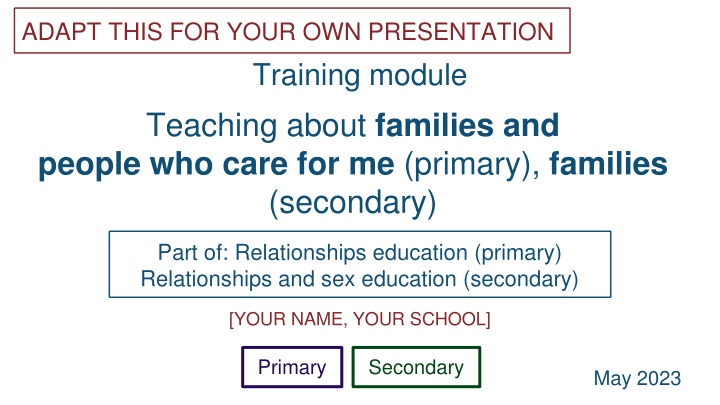

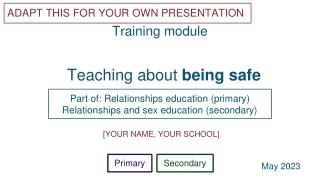
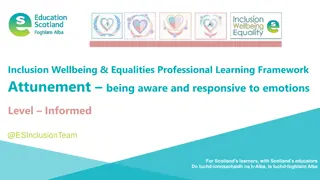

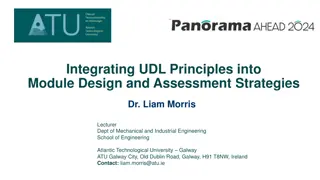
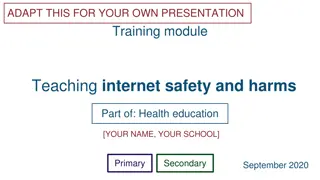
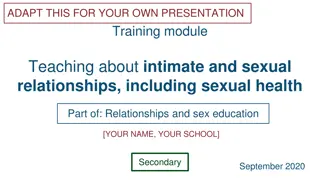

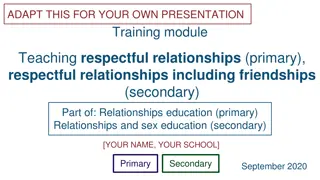
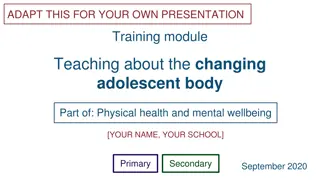
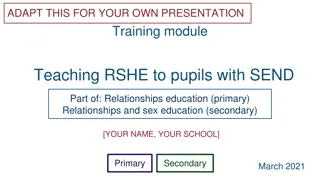
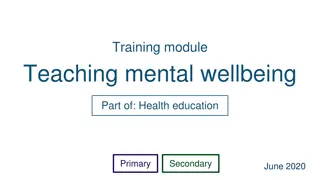
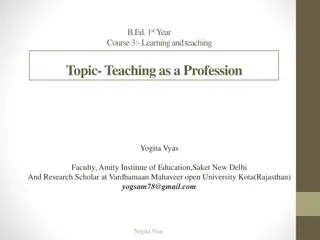

![Teaching Health and Prevention at [Your School]: Training Module for Physical Health and Mental Wellbeing](/thumb/167013/teaching-health-and-prevention-at-your-school-training-module-for-physical-health-and-mental-wellbeing.jpg)
